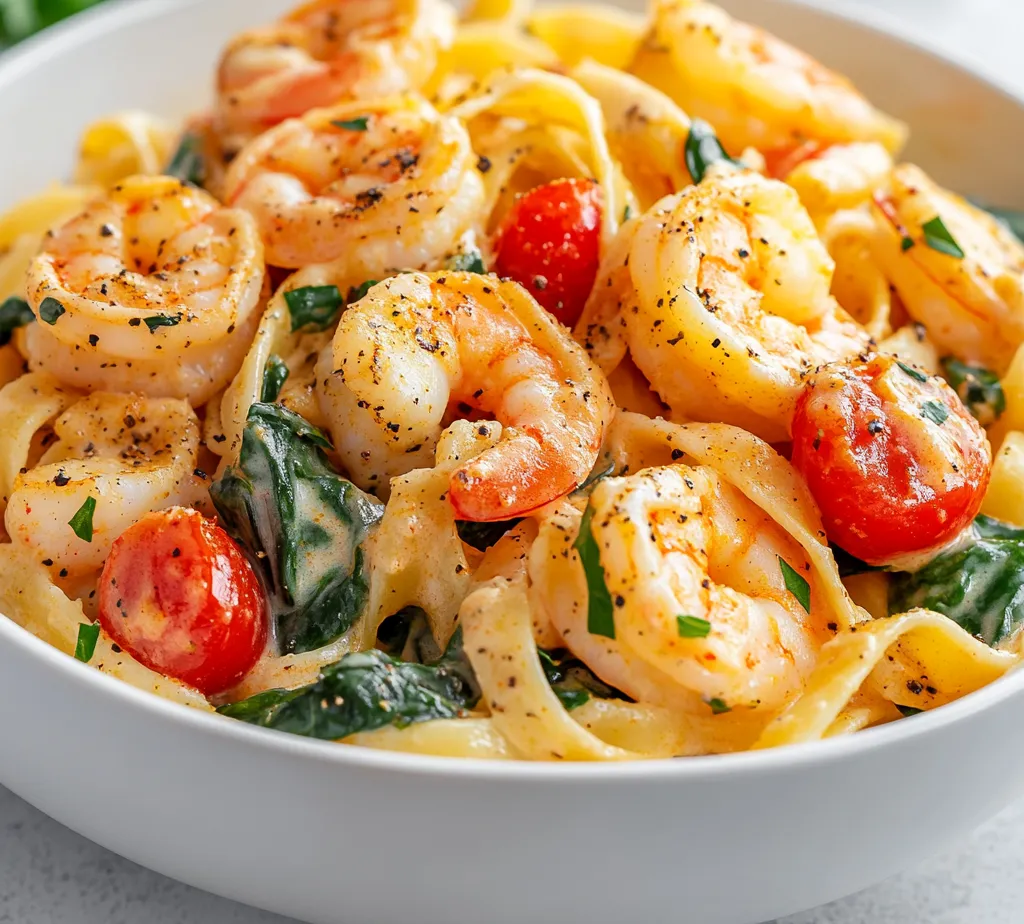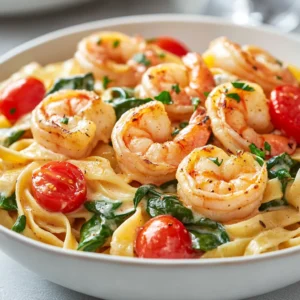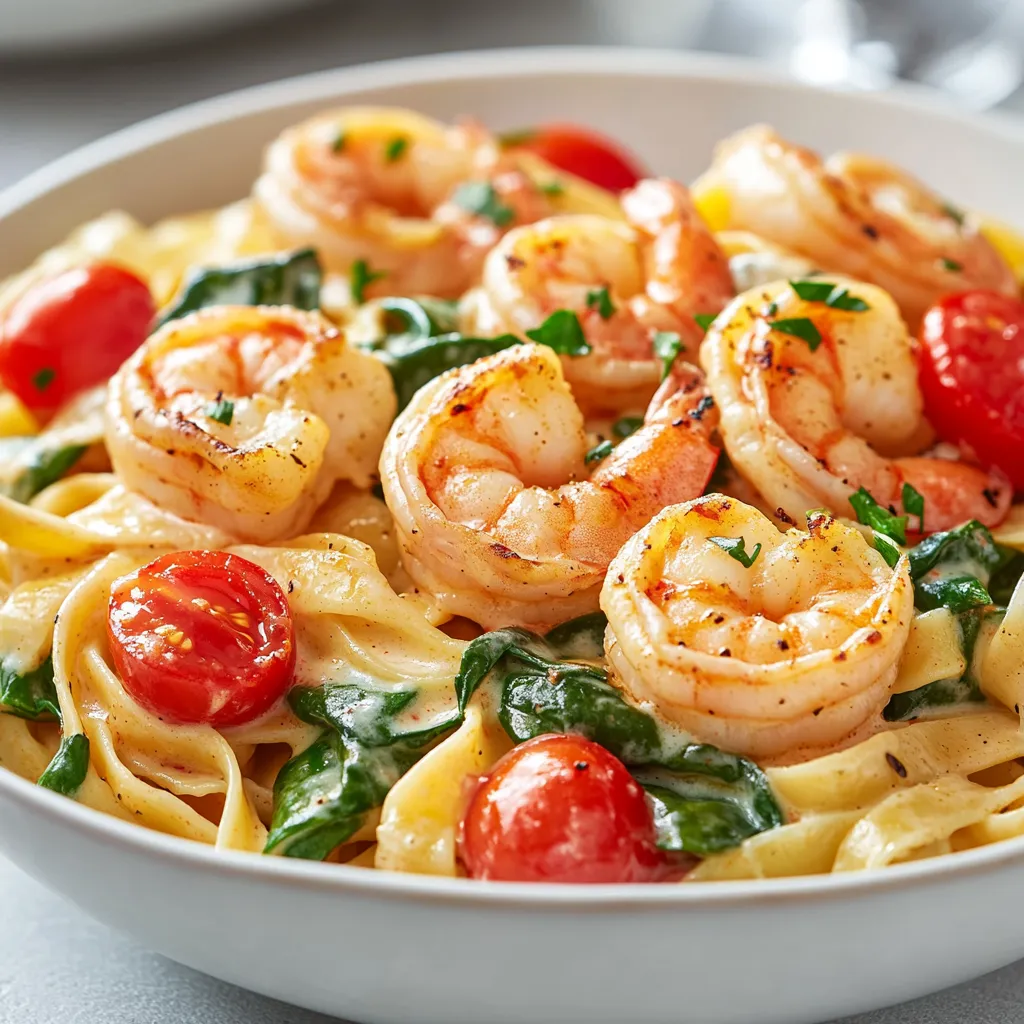Introduction
Cajun cuisine is celebrated for its bold and vibrant flavors, drawing inspiration from the rich culinary traditions of Louisiana. Known for its use of spices, fresh seafood, and diverse cooking methods, Cajun cooking makes every meal an adventure for the senses. Among the vast array of dishes that characterize this cuisine, creamy shrimp pasta stands out as a hearty and comforting option that perfectly blends the richness of cream with the dynamism of Cajun spices.
The Creamy Cajun Shrimp Pasta Delight is a remarkable dish that brings together large shrimp, seasoned with fiery Cajun spice, and envelops them in a luxurious cream sauce. Flavored with fresh garlic, bright cherry tomatoes, and tender spinach, this pasta not only satisfies hunger but also offers a culinary experience that showcases the harmonious balance between spice and comfort. Whether you need a delicious weeknight meal or a standout dish for a family gathering, this recipe encapsulates the essence of Cajun cuisine while delighting anyone fortunate enough to partake in it.
With seafood being a staple in Cajun cooking, this dish exemplifies the area’s culinary passion, featuring shrimp at its core. Perfectly cooked and seasoned shrimp are essential to experiencing the full range of flavors in this delightful pasta.
Recipe Overview
– Total Time: 30 minutes
– Prep Time: 10 minutes
– Yield/Servings: Serves 4
– Difficulty: Not specified in the recipe
The Creamy Cajun Shrimp Pasta Delight presents a harmony of flavors with the spicy kick of Cajun seasoning, the richness of heavy cream, and the light freshness brought by spinach and tomatoes. This dish is excellent for various occasions, including family dinners, casual get-togethers, or an intimate dinner for two.
Ingredients
– 8 oz fettuccine or linguine pasta
– 1 lb large shrimp, peeled and deveined
– 2 tablespoons Cajun seasoning
– 2 tablespoons extra virgin olive oil
– 3 cloves garlic, finely minced
– 1 cup heavy cream
– 1 cup freshly grated Parmesan cheese
– 1 cup cherry tomatoes, halved
– 1 cup fresh spinach leaves
– Salt and freshly ground black pepper to taste
– Fresh parsley, finely chopped (for garnish)
– Optional: A pinch of red pepper flakes for an extra kick

Instructions
1. Cook the Pasta: Begin by bringing a large pot of salted water to a rolling boil. Add the fettuccine or linguine and cook according to the package directions until al dente. Once cooked, drain the pasta, reserving about 1/2 cup of the pasta water, and set it aside.
2. Season the Shrimp: In a medium mixing bowl, add the peeled and deveined shrimp. Sprinkle the Cajun seasoning over the shrimp and toss gently until they are evenly coated with the spices.
3. Sauté the Shrimp: Heat the olive oil in a large skillet over medium-high heat. Once the oil is shimmering, add the seasoned shrimp to the skillet. Cook for about 2-3 minutes on each side until the shrimp turn pink and opaque. Once done, remove the shrimp from the skillet and set them aside on a plate.
4. Prepare the Sauce: In the same skillet, lower the heat slightly and add the minced garlic. Sauté for about 1 minute or until fragrant, being careful not to let it burn. Gradually pour in the heavy cream, stirring continuously until the mixture comes to a gentle simmer. Add the grated Parmesan cheese and stir until it melts completely, creating a rich and creamy sauce.
5. Incorporate Additional Ingredients: Add the halved cherry tomatoes and fresh spinach into the creamy sauce. Cook for an additional 2-3 minutes, allowing the spinach to wilt and the tomatoes to soften. If the sauce becomes too thick, gradually mix in some reserved pasta water until you achieve your desired consistency.
6. Combine Pasta and Shrimp: Gently return the cooked pasta and sautéed shrimp to the skillet. Toss everything together, ensuring that the pasta and shrimp are well coated with the creamy sauce. Season the dish with salt, freshly ground black pepper, and red pepper flakes if you prefer a bit more heat.
7. Serve: Carefully plate the creamy Cajun shrimp pasta, garnishing with a sprinkle of freshly chopped parsley. Serve immediately and savor the delightful blend of flavors in this spicy, cheesy dish!
Cooking Pasta
Selecting the right type of pasta is crucial for the success of this dish, as the choice of fettuccine or linguine complements the cream-based sauce beautifully. Both varieties have a flat, wide surface area, which allows for optimal sauce adhesion, ensuring each bite is brimming with flavor. When boiling pasta, it is essential to bring a large pot of water to a rolling boil to ensure even cooking and prevent clumping.
Cooking the pasta until it reaches al dente is key to maintaining the perfect texture. Al dente pasta should be firm to the bite yet tender, providing a pleasing contrast against the creamy sauce. It is also paramount to reserve some of the pasta water after draining; this starchy liquid can help adjust the consistency of the sauce later on if it becomes too thick, ensuring that your dish has the right balance and creaminess.
Seasoning the Shrimp
Properly seasoning shrimp with Cajun seasoning greatly enhances the flavor profile of the dish. The seasoning adds a depth of flavor that is both spicy and aromatic, reflecting the vibrant nature of Cajun cuisine. When preparing shrimp, it is important to ensure they are evenly coated with the seasoning. This not only enhances their flavor but also contributes to the overall taste of the dish.
It’s advisable to choose large shrimp for this recipe, as their size allows them to stand out as a prominent ingredient. Fresh shrimp are typically the best choice; however, if fresh isn’t available, high-quality frozen shrimp can work, provided they are adequately thawed and dried before seasoning. This attention to detail during the seasoning and preparation phases sets the foundation for a delightful culinary experience.
Sautéing the Shrimp
Sautéing the shrimp correctly is essential for achieving a perfect texture. Using medium-high heat and shimmering olive oil ensures that the shrimp sear properly, which adds a desirable slight crispness while still keeping the interior juicy. Cooking the shrimp for only 2-3 minutes per side allows you to develop a delectable pink and opaque exterior, indicating that they are cooked through without being overdone.
Avoid crowding the skillet during this process to enable even cooking; if necessary, cook the shrimp in batches. Once sautéed, setting the shrimp aside while you prepare the sauce allows you to preserve their temperature and texture, ensuring they remain the highlight of your Creamy Cajun Shrimp Pasta Delight.

Ideal Heat Level for Cooking Shrimp
To achieve perfectly cooked shrimp, it’s essential to maintain the right level of heat while sautéing. Cooking at medium-high heat allows the shrimp to sear properly and caramelize slightly, enhancing their natural sweetness. If the heat is too low, shrimp may become rubbery due to prolonged cooking. Conversely, excessive heat can cause them to char or overcook quickly. The sweet spot is heating the oil until it shimmers before adding the shrimp, ensuring that the result is a deliciously tender and juicy bite.
Recognizing Perfectly Cooked Shrimp
Perfectly cooked shrimp exhibit a vibrant pink color and an opaque interior. Pay attention to the transformation they undergo during cooking: they will curl slightly as they cook, forming a ‘C’ shape. If they curl into an ‘O’, this indicates overcooking. For an optimal texture, aim for about 2-3 minutes per side, depending on their size. Utilizing a meat thermometer can also help; shrimp are ideally cooked when their internal temperature reaches 120°F.
Benefits of Browning Shrimp for Added Flavor
Browning shrimp not only enhances their appearance, contributing to visual appeal but significantly boosts the flavor profile of the dish. The Maillard reaction occurs when the shrimp sugars and proteins react under high heat, creating complex, savory notes that elevate the overall taste. This added layer of depth is especially desirable in a dish like Creamy Cajun Shrimp Pasta, where the richness of the sauce pairs beautifully with the robust flavors imparted by the brown bits left in the pan.
Discussing the Maillard Reaction in Cooking
The Maillard reaction is a crucial cooking process that occurs when amino acids and reducing sugars react under heat. This process transforms simple flavors into more complex ones, producing a brown coloration and rich undertones that resonate throughout a dish. In the context of sautéing shrimp, the reaction delivers a delightful crust and intensifies the shrimp’s inherent flavor, making every bite a sensory experience.
Preparing the Sauce
Crafting a creamy sauce is an art that highlights the richness of the ingredients. Start by sautéing minced garlic in olive oil, ensuring it becomes fragrant but not burnt—aim for about one minute. Garlic can turn bitter if overcooked; thus, meticulous attention is necessary during this step.
Importance of Not Burning Garlic
Garlic is known for its strong flavor, which can become overpowering when burnt. Keeping the garlic on medium heat allows it to infuse the oil slowly, releasing its aromatic qualities without crossing into bitterness. A gentle sauté also allows other flavors, such as the heavy cream and cheese, to meld seamlessly without competing with the garlic’s essence.
Gradually Incorporating Heavy Cream
After successfully sautéing the garlic, gradually pour in the heavy cream. This technique helps to maintain a silky consistency in your sauce. By stirring continuously, you also ensure that the creamy base doesn’t separate or clump. Bringing the cream to a gentle simmer allows it to integrate fully with the sautéed garlic while avoiding overexposure to heat that could alter its texture.
Incorporating Parmesan Cheese as a Thickening Agent
Once the cream reaches a simmer, add the freshly grated Parmesan cheese bit by bit. This allows the cheese to melt evenly and prevents clumping, thereby contributing to the sauce’s desired thickness. Beyond thickening, Parmesan adds a rich, nutty flavor that complements the Cajun spices beautifully, enhancing the dish’s overall depth.
Discussing Parmesan’s Role in Flavor Enhancement
Parmesan cheese is more than just a thickening agent; it introduces umami—a savory quality that makes dishes more satisfying. This umami boost can enhance the flavors of the Cajun seasoning and fresh ingredients, creating a balanced and enjoyable dining experience.
Incorporating Additional Ingredients
Adding cherry tomatoes and spinach to the sauce is not only an enjoyable contrast of flavors but also adds nutritional value and color. Timing is key here; introducing tomatoes halfway through the sauce cooking allows them to soften while still holding some shape, adding a pleasant texture to each bite. Fresh spinach should be added last, as it wilts quickly, ensuring it retains its vibrant green color and nutritional benefits.
Adjusting Sauce Consistency
If the sauce becomes too thick during cooking, using reserved pasta water is an effective method to adjust its consistency. Start by adding small amounts of the starchy water—this enhances the sauce’s clinginess to the pasta while preserving flavors. This reserved water is beneficial as it helps to marry the sauce with the pasta, resulting in a unified dish.
Techniques for Combining Pasta, Shrimp, and Sauce
When bringing together the cooked shrimp, pasta, and sauce, a gentle folding motion with tongs effectively combines all the components without breaking the pasta or shrimp. It ensures that every element gets coated in the creamy sauce. Toss thoroughly to allow the heat from the pasta and shrimp to further amalgamate the flavors and create a harmonious dish.
Importance of Thorough Mixing for Even Coating
Even mixing is essential for ensuring that each strand of pasta is coated uniformly in the sauce. This prevents concentrated pockets of flavor and ensures that every bite is flavorful. After combining, check for final seasoning—adjust salt, pepper, and red pepper flakes to fit your preferred flavor profile.
Presentation Tips
For an appealing presentation, serve the creamy Cajun shrimp pasta in shallow bowls. An optional drizzle of extra virgin olive oil on top adds a glossy finish and enhances the flavor. To make the dish visually striking, garnishing with whole cherry tomatoes alongside the finely chopped parsley introduces contrasting colors and heightens the dish’s appeal.
Nutritional Information
The creamy Cajun shrimp pasta boasts a variety of key nutritional components. The shrimp provide high-quality protein, making this dish satisfying and wholesome. Healthy fats from the olive oil and heavy cream offer a creamy texture while contributing to its caloric content. The presence of fresh vegetables like spinach and tomatoes adds essential vitamins and minerals, reinforcing the dish’s nutritional profile.
Tips for Leftovers
To ensure the best quality of leftovers, consider storing the creamy Cajun shrimp pasta in an airtight container in the refrigerator. If possible, store the pasta and sauce separately to maintain texture, as pasta can continue to absorb sauce moisture. If already combined, enjoy the leftovers within two days to preserve freshness.
Reheating Methods to Maintain Texture and Flavor Integrity
When reheating, use a microwave or stovetop over low heat. For stovetop reheating, add a splash of cream or reserved pasta water to help restore creaminess and prevent it from drying out. Avoid reheating shrimp for too long, as they can become rubbery; just heat until warmed through.
Conclusion
Creamy Cajun Shrimp Pasta Delight showcases a spectacular combination of flavors and textures. With its balance of creamy sauce, perfectly cooked shrimp, and bright vegetables, this dish is a comforting meal that can be prepared in approximately 30 minutes. Though best enjoyed fresh, the flavors develop even further when reheated, making it a delightful option for leftovers.

Creamy Cajun Shrimp Pasta Delight Recipe
Ingredients
- 8 oz fettuccine or linguine pasta
- 1 lb large shrimp peeled and deveined
- 2 tablespoons Cajun seasoning
- 2 tablespoons extra virgin olive oil
- 3 cloves garlic finely minced
- 1 cup heavy cream
- 1 cup freshly grated Parmesan cheese
- 1 cup cherry tomatoes halved
- 1 cup fresh spinach leaves
- Salt and freshly ground black pepper to taste
- Fresh parsley finely chopped (for garnish)
- Optional: A pinch of red pepper flakes for an extra kick
Instructions
- Cook the pasta in salted boiling water until al dente, then drain and reserve ½ cup of pasta water.
- In a bowl, toss the shrimp with Cajun seasoning until evenly coated.
- Heat olive oil in a skillet over medium-high heat and sauté the shrimp for 2-3 minutes on each side until pink.
- Remove shrimp from the skillet and set aside. In the same skillet, sauté minced garlic for 1 minute.
- Pour in heavy cream, stirring until it simmers, then add Parmesan cheese and stir until melted.
- Add cherry tomatoes and spinach to the sauce, cooking for 2-3 minutes until spinach wilts.
- Combine the cooked pasta and shrimp with the sauce, adding reserved pasta water if needed.
- Season with salt, pepper, and red pepper flakes to taste.
- Plate the pasta, garnishing with chopped parsley, and serve immediately.

